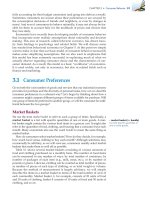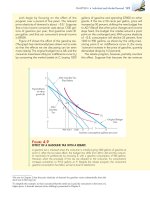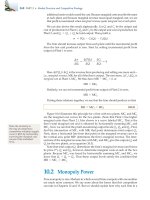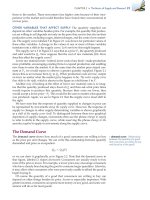(8th edition) (the pearson series in economics) robert pindyck, daniel rubinfeld microecon 115
Bạn đang xem bản rút gọn của tài liệu. Xem và tải ngay bản đầy đủ của tài liệu tại đây (144.69 KB, 1 trang )
90 PART 2 • Producers, Consumers, and Competitive Markets
Frozen yogurt
(cups per
month)
F IGURE 3.15
A
U1
A CORNER SOLUTION
U2
U3
When the consumer’s marginal rate of substitution is not equal to the price ratio for all
levels of consumption, a corner solution arises. The consumer maximizes satisfaction by
consuming only one of the two goods. Given
budget line AB, the highest level of satisfaction is achieved at B on indifference curve U1,
where the MRS (of ice cream for frozen yogurt) is greater than the ratio of the price of
ice cream to the price of frozen yogurt.
B
Ice cream
(cups per month)
This inequality would, of course, be reversed if the corner solution were at
point A rather than B. In either case, we can see that the marginal benefit–marginal cost equality that we described in the previous section holds only when
positive quantities of all goods are consumed.
An important lesson here is that predictions about how much of a product consumers will purchase when faced with changing economic conditions
depend on the nature of consumer preferences for that product and related
products and on the slope of the consumer’s budget line. If the MRS of ice cream
for frozen yogurt is substantially greater than the price ratio, as in Figure 3.15,
then a small decrease in the price of frozen yogurt will not alter the consumer’s
choice; he will still choose to consume only ice cream. But if the price of frozen
yogurt falls far enough, the consumer could quickly choose to consume a lot of
frozen yogurt.
E XA MPLE 3.4 CONSUMER CHOICE OF HEALTH CARE
Expenditures on health care in the
United States have risen dramatically over the past few decades,
a phenomenon that some people
find alarming. Some economists
have argued that these expenditures have increased so much
because our health care system is
inefficient. That may well be, but there
could also be another reason: As consumers become better off economically, their preferences shift toward
health care and away from other
goods. After all, if you already own a
nice home and two cars, what would
give you more satisfaction—a third









